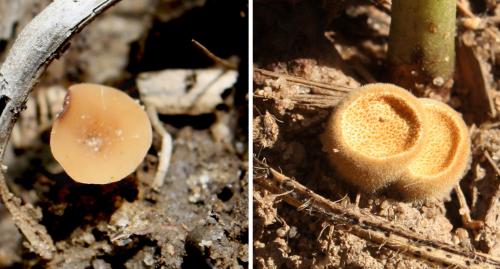White mold of soybeans and foliar fungicides
Now is the time to make a decision regarding white mold fungicide applications.

With the wet conditions we’ve been experiencing and the possibility of wet conditions during soybean flowering, now is the time to consider if a fungicide application should be made. Over the next few weeks, sclerotia of the white mold fungus (Sclerotinia sclerotiorum) will be germinating to produce 0.25-inch mushrooms (apothecia). These mushrooms release hundreds of thousands of spores capable of infecting the soybean plant through the flower petals. It should be noted that there are many other fungal species that produce mushrooms that are often confused with the white mold mushroom, especially birds nest fungus, which is a harmless organism that breaks down corn stubble and other organic debris.
Before making a fungicide application, there are a few things to consider. Has there been a history of white mold in the field in question? Are weather conditions favorable for infection (cool and moist)? How susceptible is the variety you planted? Do you have high plant populations or narrow rows? All of these things can influence the amount of disease that develops.
Be realistic about the control that will be achieved with foliar fungicides – complete control is unrealistic. Fungicides are not a silver bullet for white mold management. In Michigan State University trials, we obtained 80 percent control of white mold in 2013; however, in 2014, with highly favorable weather conditions and heavy disease pressure, we only managed to control 9 percent of disease. Once disease symptoms are present in a crop, it is too late to save infected plants.

White mold mushroom (left) and the common and harmless bird’s nest fungus (right), not to be confused with the white mold mushroom.
If fungicides are to be used, they should be applied at the beginning of flowering (R1) with a possible follow up application a week or two later, up until the beginning of pod development (R3). As the disease cycle is dependent on infection through flower petals, it is essential to get fungicides on to protect flowers; this includes correct timing as well as good penetration of fungicide product deep into the foliage. A good Michigan State University Extension article on correct sprayer setup is available at “Equipping and operating sprayers to control insects and diseases in soybeans.”
If the decision to spray is made, it is advisable to keep replicated, non-sprayed check strips in representative areas of the field to see how the fungicide application performed under your conditions. This is important as low areas that hold moisture or where cool air pools will be at greater risk for developing disease than other areas of the field. It should also be noted that not all fungicides perform equally against white mold. Endura and Aproach are two fungicides that provide good efficacy against white mold. The latest fungicide efficacy information compiled from universities across the Midwest can be found at “Fungicide Efficacy for Control of Soybean Foliar Diseases” by Purdue University Extension.
For more information, read “Management of White Mold in Soybean,” produced through the North Central Soybean Research Program.
Dr. Chilver’s work is funded in part by MSU’s AgBioResearch and the Michigan Soybean Promotion Committee.



 Print
Print Email
Email
